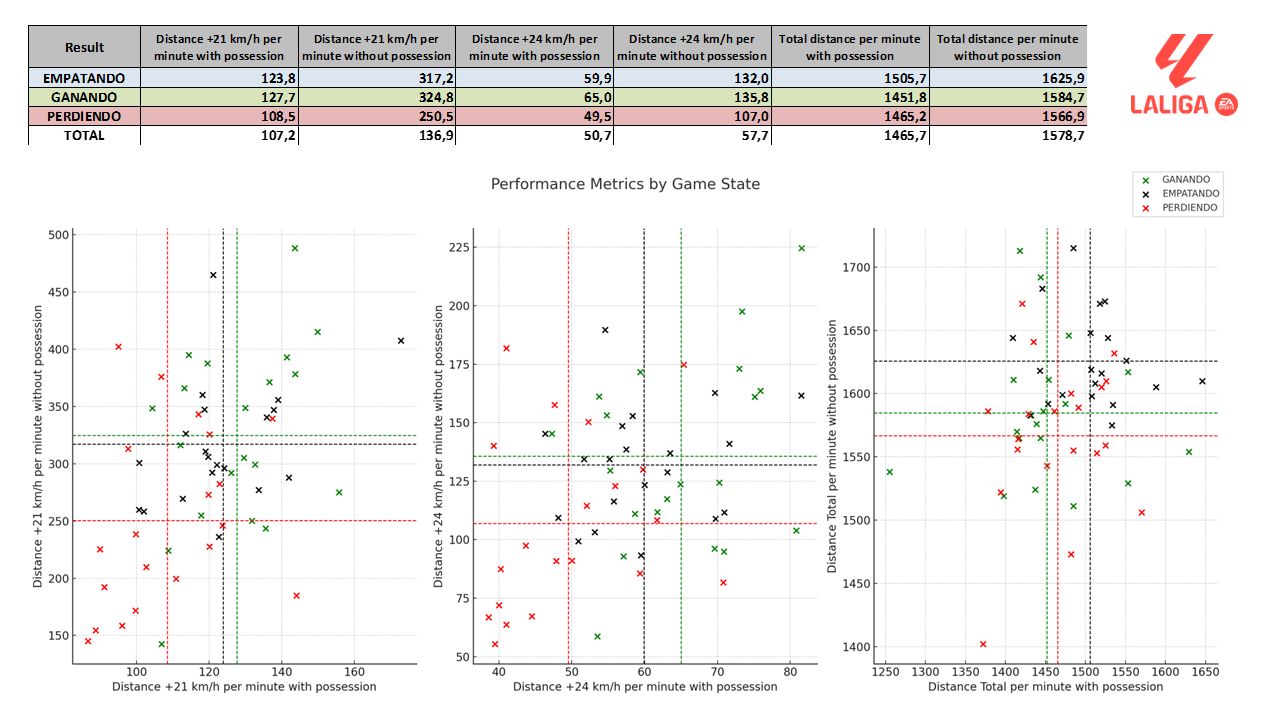
18 Jun Analysis of Physical Performance in LaLiga EA Sports 23/24 Season: When Do Teams Run the Most?

Abstract
This study investigates the physical performance of teams in LaLiga EA Sports during the 23/24 season. The primary aim is to understand how teams manage their effort in different match situations: winning, drawing, or losing. Contrary to common expectations, the findings reveal that teams do not necessarily increase their physical effort when they are losing. Detailed analyses of various physical metrics in offensive and defensive phases provide insights into the strategic and tactical adaptations of professional football teams.
Introduction
Physical performance is a critical component of success in professional football. Understanding how teams manage their effort in different match contexts can provide valuable insights for coaches, trainers, and analysts. This study examines the physical performance data from LaLiga EA Sports 23/24 season to determine when teams exert the most effort: when winning, drawing, or losing.
Methodology
Data Collection
The dataset includes average physical performance metrics for all teams in LaLiga EA Sports during the 23/24 season. Metrics are divided into two phases: offensive (with possession) and defensive (without possession). The data is further categorized based on the match situation: winning, drawing, and losing, regardless of the final outcome of the match.
Metrics Analyzed
The following metrics were analyzed:
- Distance covered per minute at speeds over 21 km/h (offensive and defensive phases).
- Distance covered per minute at speeds over 24 km/h (offensive and defensive phases).
- Total distance covered per minute (offensive and defensive phases).
Statistical Analysis
ANOVA tests were conducted to determine if the differences in physical performance metrics across the three match situations (winning, drawing, losing) were statistically significant. Additionally, a comparative analysis was performed for each team to verify if their behavior aligned with the global trends.
Results
Global Trends
- Greater Effort in Defensive Phase: In all conditions, teams cover more distance in the defensive phase. For instance, while drawing, teams cover an average of 691.70 meters per minute without possession compared to 563.13 meters per minute with possession. When winning, teams cover 681.74 m/min without possession and 548.15 m/min with possession. When losing, teams cover 641.44 m/min without possession and 541.08 m/min with possession.
- Consistency in Defensive Effort: Defensive effort remains high, especially when teams are drawing (691.70 m/min) or winning (681.74 m/min), suggesting a focus on ball recovery and applying pressure.
- Offensive Effort: Although lower than in the defensive phase, offensive effort is also significant. While drawing, teams cover 563.13 m/min, when winning 548.15 m/min, and when losing 541.08 m/min with possession.
Surprising Finding
Contrary to what might be expected, teams do not increase their physical effort when they are losing. In fact, they cover less distance at high speeds and overall, both in the offensive and defensive phases.
Team-by-Team Analysis
The team-by-team analysis showed that the trends observed in the global analysis were consistent across most teams. This reinforces the notion that strategies for managing effort and applying defensive pressure are uniformly adopted across LaLiga EA Sports teams.
Discussion
Implications for Training and Strategy
The findings have significant implications for training and match strategies. The high physical demand in the defensive phase highlights the importance of training for endurance and quick recovery. The consistent defensive effort across different match situations suggests that teams prioritize maintaining defensive solidity and pressure, regardless of whether they are winning, drawing, or losing.
Tactical Adaptations
The lack of increased physical effort when losing could indicate strategic conservation of energy or different tactical approaches that do not rely solely on increased physical exertion. This might include maintaining possession, controlling the tempo, or focusing on strategic positioning rather than relentless running.
Limitations and Future Research
While the study provides valuable insights, it is limited to the physical performance metrics available. Future research could incorporate additional variables such as player fatigue, psychological factors, and in-game tactical changes to provide a more comprehensive understanding of team performance dynamics.
Conclusion
This study reveals that LaLiga EA Sports teams do not necessarily increase their physical effort when losing. Instead, they maintain high defensive effort across all match situations. These findings can inform training programs and tactical strategies, helping teams optimize performance and energy management during matches.


